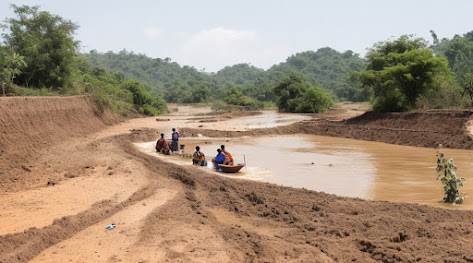Climate change is one of the most pressing challenges facing humanity today. Its far-reaching consequences are becoming increasingly evident, from rising global temperatures to more frequent extreme weather events. Addressing climate change requires a coordinated, global effort, and this article explores a wide range of solutions from renewable energy to policy measures, all aimed at combatting this urgent crisis.
1. Renewable Energy: A Key Component of Climate Change Solutions
Renewable energy stands as a cornerstone in the fight against climate change. The shift from fossil fuels to clean energy sources like wind, solar, and hydroelectric power is pivotal in reducing greenhouse gas emissions. Across the globe, countries are investing in renewable energy infrastructure, making strides toward a sustainable future.
One remarkable example is Denmark, which has become a leader in wind energy. The country generates a substantial portion of its electricity from wind turbines, significantly reducing its carbon footprint. Additionally, China's ambitious solar energy projects are making it a major player in the renewable energy sector. These initiatives showcase the transformative potential of clean energy sources.
2. International Agreements: Collaborative Efforts to Combat Climate Change
International agreements and treaties play a vital role in addressing climate change on a global scale. The Paris Agreement, adopted in 2015, stands as a prime example of diplomatic collaboration to combat climate change. This historic accord brings together countries from around the world, pledging to limit global warming to well below 2 degrees Celsius above pre-industrial levels.
The Paris Agreement encourages countries to set their own emission reduction targets and regularly report on their progress. It promotes transparency and accountability, fostering a sense of collective responsibility in the battle against climate change. Such global cooperation is essential to ensuring a sustainable future for generations to come.
3. The Role of Technology in Climate Change Mitigation
Technology plays a crucial role in mitigating climate change. Innovative solutions, such as carbon capture and storage (CCS) and advanced energy-efficient technologies, are helping reduce emissions across various sectors. CCS technology, for instance, captures carbon dioxide emissions from industrial processes and power plants, preventing them from entering the atmosphere.
Moreover, advancements in electric vehicles (EVs) are transforming transportation. Companies like Tesla are pioneering the development of high-performance electric cars, making them more accessible to the public. The rise of EVs reduces greenhouse gas emissions from the transportation sector, a major contributor to climate change.
4. Adapting to a Changing World: Climate Resilience Strategies
As climate change continues to unfold, adaptation is equally crucial as mitigation. Communities worldwide must develop resilience strategies to cope with the impacts of a changing climate. This includes preparing for more frequent and severe weather events, rising sea levels, and shifting agricultural patterns.
In Bangladesh, a country vulnerable to sea-level rise and cyclones, innovative strategies like floating gardens and resilient crop varieties are helping communities adapt to changing conditions. Additionally, cities like Rotterdam in the Netherlands have implemented robust flood protection systems to safeguard against rising waters. These adaptation measures are essential for ensuring the well-being of populations in the face of climate change.
5. Sustainable Agriculture: Feeding the World While Reducing Emissions
Agriculture is both a significant contributor to greenhouse gas emissions and a sector highly susceptible to the impacts of climate change. Sustainable agricultural practices are essential for addressing these challenges. Farmers are adopting techniques like no-till farming, precision agriculture, and organic farming to reduce emissions and improve soil health.
Furthermore, vertical farming and hydroponics are emerging as innovative solutions to produce food more efficiently and with fewer emissions. These methods require less land, water, and chemicals, making them environmentally friendly alternatives to traditional agriculture.
6. Protecting Ecosystems: Conservation in the Face of Climate Change
Conservation efforts are vital for preserving biodiversity and mitigating climate change. Ecosystems like forests and wetlands act as carbon sinks, absorbing carbon dioxide from the atmosphere. Protecting and restoring these ecosystems is crucial in the fight against climate change.
In Brazil, the Amazon Rainforest, often referred to as the "lungs of the Earth," faces ongoing threats from deforestation. Conservation organizations and governments are working to combat illegal logging and land clearance, aiming to safeguard this critical carbon sink. Similarly, the restoration of degraded wetlands in the United States is helping sequester carbon and protect vulnerable ecosystems.
7. Transportation Transformation: Greening Global Mobility
The transportation sector is a significant contributor to greenhouse gas emissions. Greening global mobility is essential to combat climate change. Electric vehicles (EVs) are becoming increasingly popular, and governments are incentivizing their adoption through subsidies and charging infrastructure expansion.
Countries like Norway have led the way in EV adoption, with a substantial percentage of new cars being electric. Additionally, investments in public transportation and the development of cycling and pedestrian-friendly infrastructure reduce the reliance on private vehicles and promote more sustainable modes of transportation.
8. Circular Economy: Reducing Waste and Emissions
A circular economy model focuses on reducing waste and reusing resources efficiently. It aligns with climate change solutions by reducing emissions associated with resource extraction and manufacturing. Companies are increasingly adopting circular practices, such as recycling and upcycling, to minimize their environmental footprint.
The fashion industry, notorious for its waste and emissions, is transitioning toward circularity. Brands are designing clothes for longevity, using sustainable materials, and implementing take-back programs to recycle old garments. This shift in approach promotes sustainability while mitigating climate impacts.
9. Empowering Communities: Grassroots Climate Change Solutions
Communities and individuals play a crucial role in climate change solutions. Grassroots movements and community-led initiatives are empowering people to take action locally. Community gardens, clean energy cooperatives, and educational programs are driving change from the ground up.
Community-led projects like the Transition Town movement in the UK promote sustainability and self-sufficiency at the local level. These initiatives foster resilience and reduce carbon footprints, showcasing the potential of bottom-up climate action.
10. Carbon Pricing: Economics of Climate Change Mitigation
Implementing a price on carbon emissions is an effective economic tool for mitigating climate change. Carbon pricing mechanisms, such as carbon taxes and cap-and-trade systems, create economic incentives for businesses and individuals to reduce their emissions.
Countries like Sweden and Canada have successfully implemented carbon pricing, reducing emissions while generating revenue for climate initiatives. These policies demonstrate the potential of market-based approaches to address climate change.
11. Climate Education: Raising Awareness and Fostering Action
Climate education is essential for raising awareness and fostering action on climate change. Schools, universities, and organizations are incorporating climate curriculum and awareness campaigns to inform the public about the urgent need for climate action.
Youth-led movements like Fridays for Future, inspired by climate activist Greta Thunberg, are advocating for climate education and policy change. These efforts are mobilizing a new generation of climate activists and creating a sense of urgency among policymakers.
12. Green Infrastructure: Building Resilient Cities
Green infrastructure, including green roofs, urban parks, and permeable pavements, enhances the sustainability and resilience of cities. These features help manage stormwater, reduce urban heat island effects, and improve air quality.
Cities like Singapore are renowned for their green infrastructure projects. The city-state has integrated lush greenery into its urban landscape, making it an exemplar of sustainable urban planning. Such initiatives improve the quality of life for urban residents while reducing the environmental impact of cities.
13. Innovations in Carbon Capture and Storage
Innovations in carbon capture and storage (CCS) technologies are essential for addressing emissions from industrial processes and power generation. Enhanced CCS methods are being developed to capture and store carbon dioxide more efficiently.
Projects like the Petra Nova facility in Texas, USA, demonstrate the potential of CCS technology by capturing CO2 emissions from a coal-fired power plant and injecting them underground for long-term storage. These innovations hold promise in reducing emissions from industries that are difficult to decarbonize.
14. The Role of Policy and Government in Climate Change Solutions
Government policies and regulations are critical drivers of climate change solutions. Countries worldwide are implementing a range of policies, from renewable energy incentives to emissions reduction targets, to drive action on climate change.
Germany's Energiewende, or energy transition, is a prime example of comprehensive government policy aimed at transitioning to renewable energy sources. Through subsidies and regulatory support, Germany has become a leader in the global renewable energy industry.
15. Climate Finance: Funding a Sustainable Future
Climate finance is essential for funding climate change solutions. Investment in renewable energy, sustainable infrastructure, and adaptation projects is crucial to accelerate the transition to a low-carbon economy.
The Green Climate Fund, established under the United Nations Framework Convention on Climate Change, mobilizes financial resources to support developing countries in their climate change efforts. Climate finance helps bridge the gap between ambition and action in the global fight against climate change.
In conclusion, addressing climate change requires a multifaceted approach that encompasses renewable energy, international agreements, technological innovation, adaptation strategies, sustainable agriculture, ecosystem conservation, and more. By collectively embracing these climate change solutions, the global community can work towards a more sustainable and resilient future for all.

















0 Comments